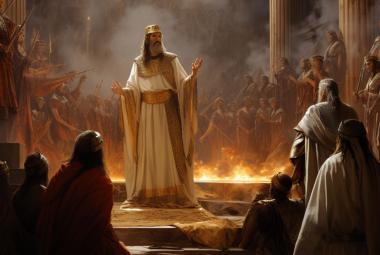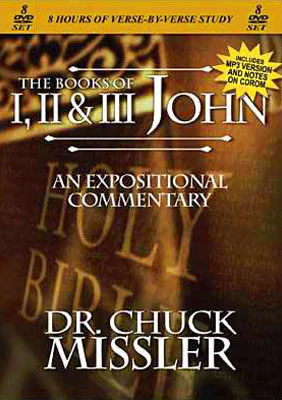The early church in the first century was under attack from both the inside and the outside. So what has changed? It should not surprise us that the Holy Spirit has anticipated every conceivable form of attack and diversion, and the three epistles of John are full of insights that are timely for each of us - at the personal level as well as the corporate. John, the "beloved disciple" 1 and one of the inner circle,2 was the author of five books of the New Testament: the Gospel of John, Revelation and three very unique and distinctive epistles: I, II, and III John. Let's examine these remarkable letters in reverse order.
3rd John
This is a brief, practical letter in which three Christians appear: Gaius, the encourager, to whom it is addressed; Diotrephes, the self-exalting dictator; and Demetrius, a role model to follow. In this very short note we find valuable encouragement, timely warnings, and critical insights for own current assemblies. (Our expositional notes also include an appendix on the "most painful sin": gossip.)
2nd John
This is a mystery letter:3 The letter is addressed to "the Elect Lady," and her children. Κυρία is a feminine proper name; but εωκλεκτη is a strange construction, never assigned to any other individual in the New Testament as a single predicate. 4 There are two prevailing views among the abundance of expositors as to whom this letter is addressed:
- to the church at large, and
- to a prominent individual within the church.
A Provocative Conjecture
But there is a third possibility. Who would be the most "Elect Lady" in the entire Bible? To me, the most likely prima facie suggestion (which, however, is not even discussed among most commentators5 ) would be that the recipient of this intimate letter is the most "elect" lady of all women, the very one that Jesus Himself entrusted to John's personal care: Mary, the mother of Jesus!6
In fact, it is surprising that Jesus didn't consign her to one of her other four sons. Jesus was raised among a family of at least seven: five brothers and two sisters.7 James and Jude became believers after the resurrection, and, in fact, each wrote the books in the New Testament that bear their names. Jesus appeared to James after His resurrection.8 If our surmise is correct-and it is only a surmise-the others probably also became believers. 9 And Mary did have a sister as alluded to in v.13. 10 We know so little of her subsequent history from the Scriptures; there are only minimal allusions in the Book of Acts. 11 She apparently remained in the care of John in his retirement in Ephesus.
Obviously, most of what is commonly published by the Roman Catholic Church has been contrived to promote a number of doctrinal heresies. 12 Most Biblical believers, from their revulsion to the tragic and heretical deification of Mary, tend to disregard her altogether and ignore her situation and predicament. (We cannot miss the ostensibly dismissive allusion at her prompting during the wedding at Cana.13)
"The Truth"
The "Elect Lady" is loved "by all they that have known the Truth." 14 Who else would be loved by all other believers? To whom else could this refer? This, too, seems to point to far more than simply a prominent personage within their local church! Clearly, the prominence of "truth," in concert with "love," is the keynote of this letter. John uses the word "truth" five times in the first four verses. He uses the word "love" four times. However, in this letter, we learn that Truth "dwells in us and shall be with us forever" (v.2). "The Truth" may be intended as a more personal title. Even Pilate's cynical question still echoes in our ears, "What is Truth?" For believers, Jesus' declaration is conclusive and comprehensive: "I am the Way, the Truth, and the Life."15 It would seem that John is using, here, Truth as a title of Jesus Christ, just as he so often uses the Logos, The Word. 16
(The recipient of John's letter also was not a latecomer: she was there "from the beginning."17 ) If our suspicion is correct, it would place a unique complexion on the entire letter, and it would also yield a number of other significant insights.
We should not presume that any of us are beyond the need for encouragement or exhortation. Why would Mary-a blessed but human believer-be any exception? Especially during a time when widespread attacks on the deity of Jesus Christ were the topics of the day! Mary was subject to the same frailties as all of us: pride, doubts, and a need of frequent encouragement, counsel, and, perhaps, exhortation. A tendency toward pride could certainly have been her most serious challenge: the most blessed of all women who had ever walked the earth! And yet, having to live with the clouds of legitimacy and other doctrinal issues over her firstborn.18 Read through the 2nd Epistle of John from Mary's perspective, and see what the Spirit confirms to you.
1st John
Here is one of the most loved epistles in the entire New Testament. I John has been called the sanctum sanctorum of the New Testament, and is a climax after the other two. It is really more of a sermon than a personal letter. It develops, in detail, the themes of love and truth introduced in II John. It takes the child of God into the fellowship of the Father's home. (Paul's epistles, and all the other epistles, are church epistles; but this is a family epistle. It may prove more important to the individual believer than all the church epistles!)
It is interesting that while John develops the overwhelming themes of love and truth, he also employs heptadic structures just as he does in his Gospel and Revelation. We find:
Seven Contrasts: The Light vs. The Darkness (1:5-2:11), The Father vs. The World (2:12-2:17), Christ vs. the Antichrist (2:18-2:28), Good Works vs. Evil Works (2:29-3:24), Holy Spirit vs. Error (4:1-4:6), Love vs. Pious Pretence (4:7-4:21), and The God-Born vs. others (5:1-5:21).
Seven Tests: Of Profession (1:5-2:11), Of Desire (2:12-2:17), Of Doctrine (2:18-2:28), Of Conduct (2:29-3:24), Of Discernment (4:1-4:6), Of Motive (4:7-4:21), Of New Birth (5:1-5:21).
Other heptadic structures include: seven traits of the born again (2:29; 3:9; 4:7; 5:1 (2x), 4, 18); seven reasons why this epistle was written (1:3, 4, 2:1, 13-17, 21-24, 26, 5:13); seven tests of Christian genuineness (1:6, 8, 10; 2:4, 6, 9, 4:20); and, seven tests of honesty and reality (1:6, 8, 10; 2:4, 6, 9; 4:20). (However, we find only six liars: 1 Jn 1:6, 10; 2:4, 22; 4:20; 5:10.) In any case, John's three letters focus on our walking in love, in truth, and in the intimate knowledge of God. They deal with, in a sense, a challenge similar to the famous indictment by the Prophet Hosea:
Hear the word of the LORD, ye children of Israel: for the LORD hath a controversy with the inhabitants of the land, because there is no truth, nor mercy, nor knowledge of God in the land.
Hosea 4:1
The issue in all three letters is that love and truth must be practiced: "walked." "To walk in the truth" means to obey it. It is easier to study the truth, or even argue about the truth, than it is to obey it. Knowing the truth is more than giving assent to a series of doctrines; it means that the believer's life is controlled by a love for the truth and a desire to magnify the truth. We encourage you to explore our expositional commentaries on these three letters.
Notes:
- John 19:26; 20:2; 21:7; 21:20.
- Present at Jairus' daughter (Mk 5:37), Transfiguration (Mt 17:1), Gethsemane (Mt 26:37), and the private briefing on Jesus' 2nd Coming (Mk 13:3).
- See Personal UPDATE , April 2001, for a detailed study.
- Except in Romans 16:13, "chosen in the Lord."
- So far, I haven't found any that support the idea of Mary except Knauer (Stud. U. Krit., 1833, Part 2, p.452ff (q.v. J. E. Huther, Critical and Exegetical Handbook to the General Epistles of James, Peter, John, and Jude , (translated from the German), 11 vols, Funk and Wagnalls, 1884.).
- John 19:26, 27.
- Matthew 13:55, 56; Mark 5:3.
- 1 Corinthians 15:7.
- Cf. v.4 (however, the Greek actually indicates "some" of thy children).
- John 19:25.
- Acts 1:14.
- See Dave Hunt's A Woman Rides the Beast (Harvest House, Eugene OR 1994) for a comprehensive, well-documented and timely review.
- John 2:4.
- 2 John v.1.
- John 14:6.
- John 1:1-3, 14, 1 John 5:7, Rev 19:13.
- Cf. vv.5 & 6. The "we" suggests a provocative joint identity with John.
- John 8:41.







